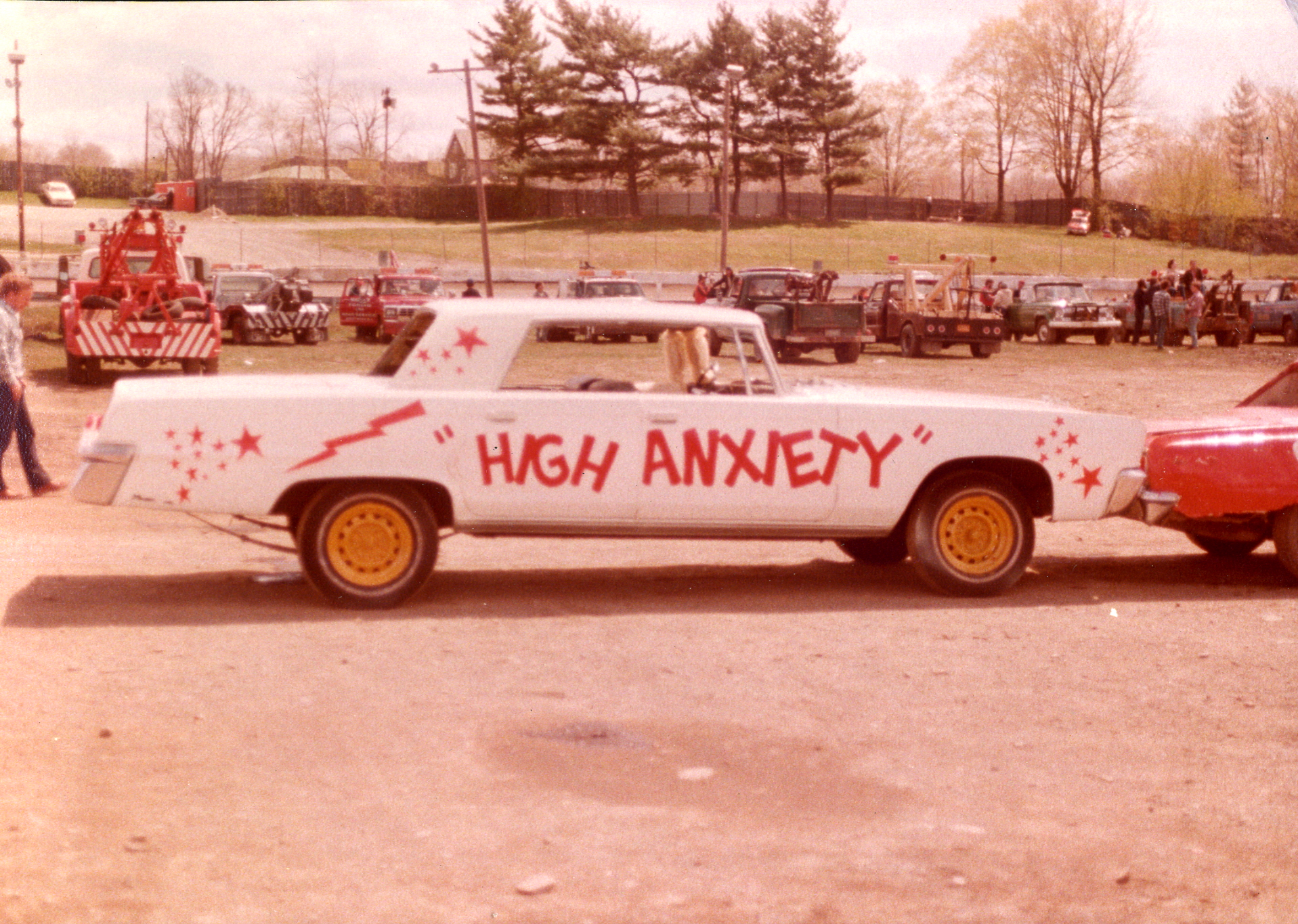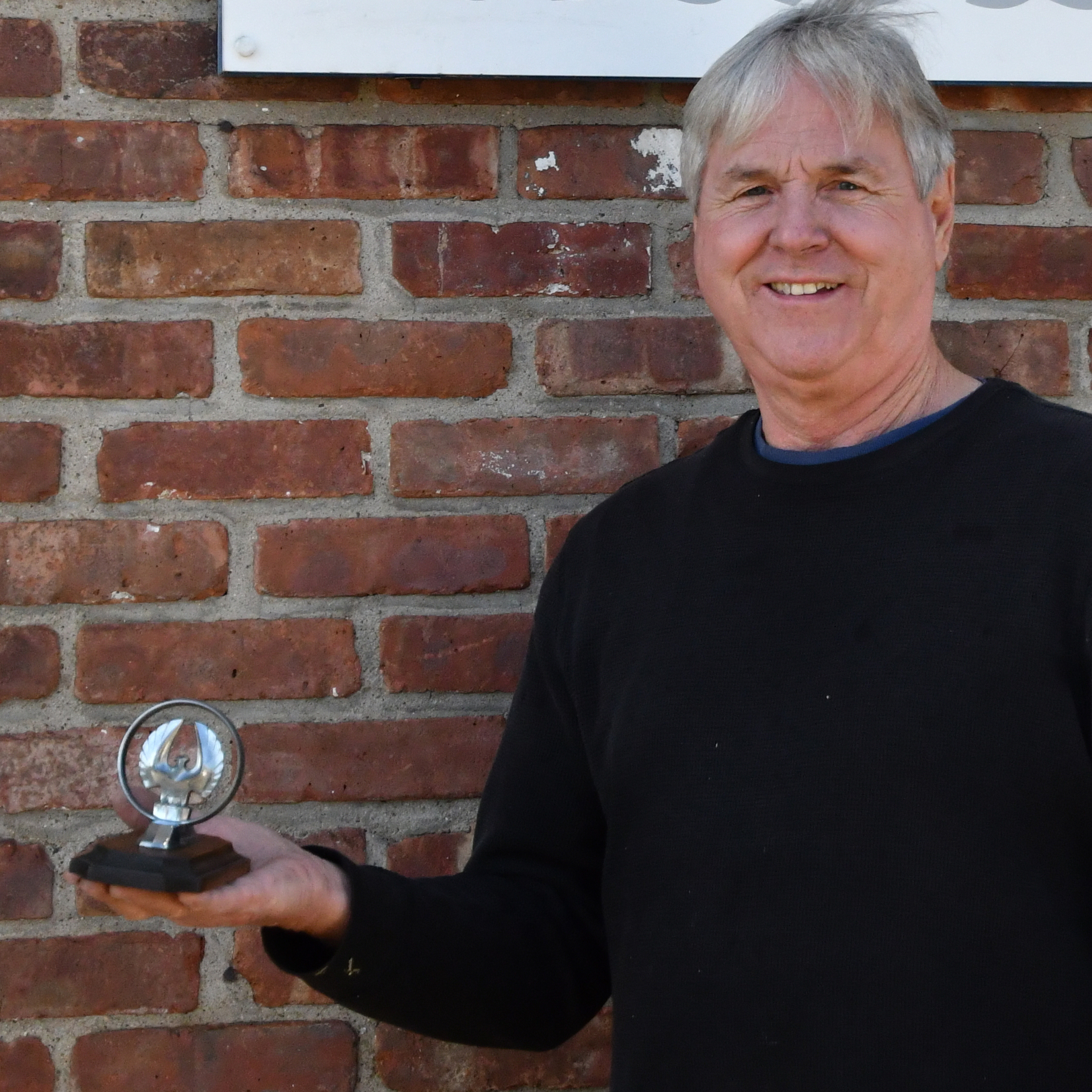Last week my F100 pickup required a flatbed. Upon calling AAA I discovered that while a flatbed would be sent for my truck, I could not accompany my vehicle, AAA’s Covid policy. It would be up to me to get personal transportation.
AAA only tells you this when you call for assistance. Questions relating to proper delivery of the vehicle and disposition of the vehicle key remained unanswered. Be warned.
Luckily in my case, a friend nearby came to my rescue. We accompanied the flatbed to the repair shop.
In a classic lemons to lemonade story, while visiting the repair shop the following day, owner and good friend Bob Tasman shared a great story as retold below.
Confessions of a demolition derby survivor

High Anxiety
Bob Tasman epitomizes the hard core automobile driving enthusiast who grew up in the mid-twentieth century’s golden age of the automobile.
As a Drivin’ News reader, Bob while looking at my truck tossed out an offhand comment about a recent Drivin’ News story that described a teenager’s passion for driving in demolition derbies (“Crash course for an underage driver”).
Though a big time dirt track racer for many years, Bob said, “Reading that story gave me an instant flashback to my first involvement in demolition derbies.”
Since the 1970s Bob had been competing in dirt track racing, often at the Orange County, NY Fairgrounds. Like dirt track racing, demolition derby enjoyed a great following at the Fairgrounds with a highlight being the demolition derby held at the annual fair.

OUCH!
1982 saw Bob and a number of dirt track racing buddies decide demolition derby looked like fun. To a man “Let’s all do it” rang out as the dirt track racers’ battle cry.
When asked if he had any trepidations about entering his first demolition derby and a very serious one at that, Bob says, “I was a race car driver. I pretty much figured I wouldn’t be seeing anything I hadn’t seen before. I mean I’ve crashed. I’ve been on fire.” Bob understood the prevailing mindset for anyone entering this land yacht battering ram version of a steel cage wrestling match saying, ”I think probably the best asset anybody can have in a situation like this would be the killer instinct.”
Clearly Bob knew it would not be for the faint of heart. It promised two-ton behemoths colliding at high speeds generating tremendous crashes. Saying, “It was exciting to me,” displays Bob’s eager attitude towards participating in the motor mayhem.
With the July demolition derby date fast approaching, job one demanded finding the right car. Basic vehicle specs for demolition derby survival consisted of massive four-door Detroit Iron with a big torquey V8.
Four-doors rated above two-doors because of their greater length. Additional length offered a larger cushion for withstanding damage before something terminal could happen.

1964 Chrysler Imperial before High Anxiety makeover
Right out of the gate, for the less than princely sum of $75, Bob scored the perfect car, a four-door 1964 Chrysler Imperial.
Bob’s Imperial measured an impressive 19 feet in length with long overhangs measuring a robust impact withstanding 6 1/2 feet wide. It weighed in at roughly 2.5 tons with a 0-60 time of 7.7 seconds courtesy of a 413 cu. in. Chrysler V8 delivering 470 lb.-ft. of torque at around 2500 rpm. But wait there’s more. Imperials of that year had welds not bolts anchor the front fenders to a beefy chassis for a quieter ride of little interest for demolition derbies. However, welded front fenders also translated into greater strength for surviving brutal impacts.
Interestingly, mid-60s Chrysler Imperials enjoyed such a reputation for being notoriously tough that they frequently suffered banishment from the derby circuit.
It is interesting to note that this sturdy unyielding construction effectively reduced the damage to the car resulting from a collision. Unlike modern cars it transferred the energy of the impact to the occupants inside. Modern cars enjoy impact absorbing crumple zones that dissipate and redirect the energy of a collision away from the occupants. Thus, modern car designs are bad for demolition derbies but good for modern drivers.
Not satisfied with having acquired an Imperial that would gain a feared reputation as the Cleopatra’s barge of demolition derby destruction, Bob set out to upgrade its defenses.
A first step not so much to add lightness in the spirit of Colin Chapman but to increase driver safety required removing all glass and ripping out all interior components except the front seat.

Welding trunk of High Anxiety
Bob as a racer, an innovator and a fabricator had only just begun.
Cutting off the exhaust system eliminated the threat of it wrapping around the axel or drive shaft.
Removal of the radiator, an easy target for knocking a car out of competition followed. By running the upper and lower radiator hoses through a small pressure tank, Bob could simply remove the radiator and eliminate a major liability.
Since it is best to keep a car from squatting down when hitting someone, the shock absorbers were removed. A piece of angle iron was cut to match the distance between the upper and lower shock mounts when fully extended. Welding it in place ensured that the Imperial aligned with other vehicles to do maximum damage.
Anticipating brutal collisions that would surely break the motor mounts. This called for the engine to be chained to the chassis so it would remain in place and not jamb the throttle.
Batteries would be repositioned in a milk crate on the passenger side front seat. Tire pressure pumped up to 60 psi significantly reduced flexibility and susceptibility to puncture.
Two inspired finishing touches dealt with a second major vulnerability, the gas tank. Bob cut a hole in the floor of the trunk and another through the top of the gas tank, He filled the tank with wet sand.
For a replacement tank impervious to destruction, a bulk head added behind the back seat area concealed a much smaller but adequate gas tank from a Volkswagen. To make the whole rear-end assembly one piece simply required welding the trunk shut and the bumper to the chassis.

Killer instinct in action
Finally the finishing touch of chaining the front and rear doors together made everything ready for paint. A brush would do. Christened High Anxiety, the ’64 Imperial had its game face on when it lined up for the heat.
Unlike readying the cars, driver preparation called for little more than a helmet and a lap belt. Other than that, jeans and a t-shirt met with full approval.
Bob admits to a little apprehension as the two dozen competitors divided into two rows and positioned facing the opposing line back end to back end separated by about 200 feet. Bob says, “I saw all these cars and I knew they were all there for one reason.” However, once the flag dropped, for Bob, the fun just started.
Even in reverse, speeds of the rearward charging Detroit Iron battering rams easily reached 40 mph. Bob says, Your head had to be on a constant swivel. If you see it coming you can prepare yourself.
So how did Bob make out. He says, “It came down to me and one other car.” Bob was confident. High Anxiety continued to run strong though a fuel line had started leaking. Bob positioned himself secure in his ability to close out the last competitor. He does point out that there was the issue of the fire.
Bob says, “Granted the front of High Anxiety was on fire, flames leaped out from around the hood and fanned out through the front wheel wells. But my adrenaline was pumping. I thought, hey, the car’s running. I’m still going and I’m after this guy.” Bob recalls thinking that he was a race car driver and had been through all sorts of situations and didn’t feel unsafe. Derby officials did not agree. Bob got the signal to shut it down. Figuratively he was toast.
In the minds of the officials, that was literally what they wanted to avoid.

Bob Tasman with the last remaining piece of High Anxiety, the hood ornament

Burton, Great story. I am still smiling and I am not even a “car person”. You made the story fun even for the uninformed.
Bobbie
Thank you. That is a great compliment and it is much appreciated.
Burton
Thanks for another great read. You do know how to tell a story. Bob Tasman must be a lot of fun to play with. But why was that neat truck on a flat bed?
Galen
Thank you. Bob Tasman is absolutely “Sons of Danger” Material. F100 Brakes locked up. Traced to heated brake fluid and corrected.